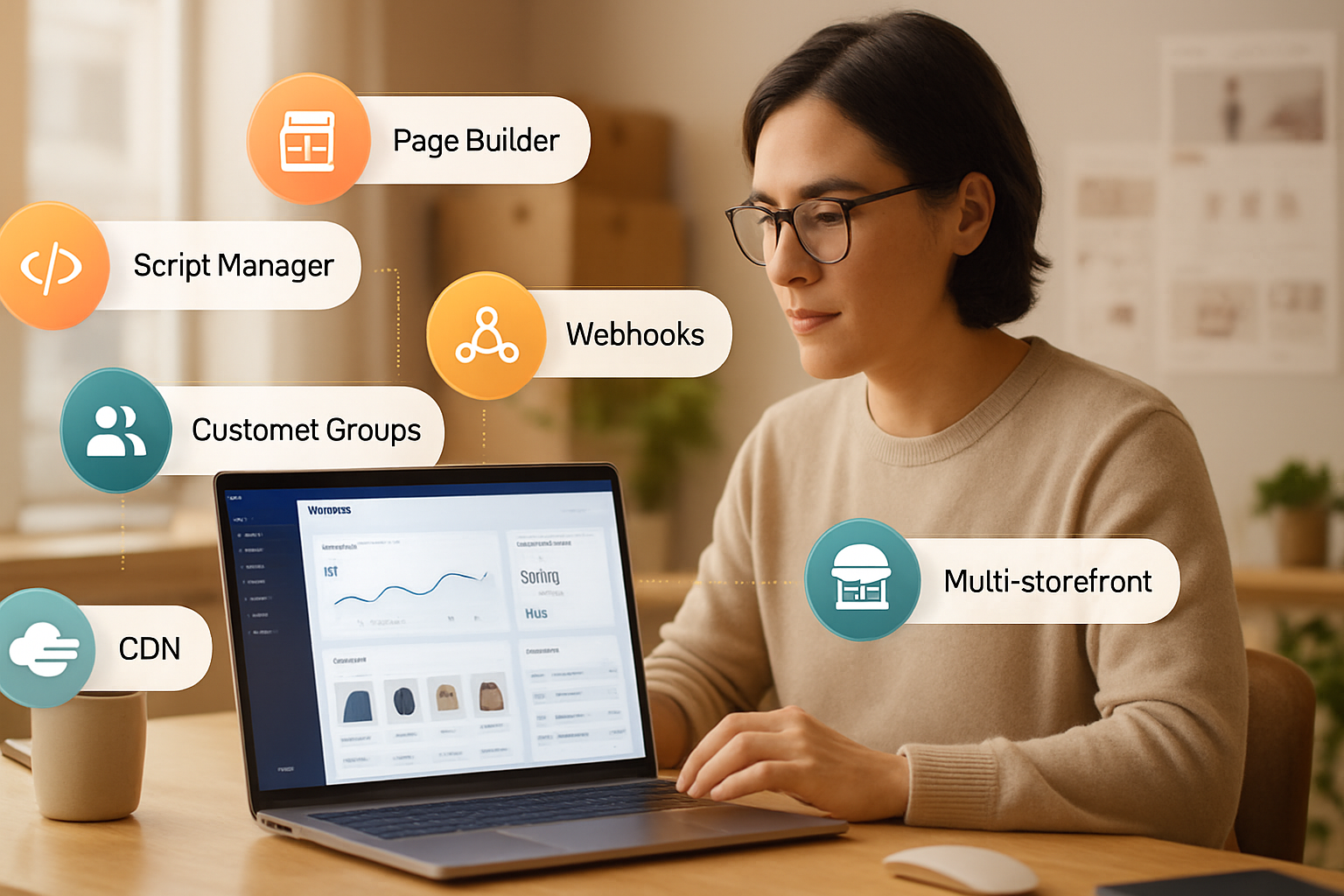· business · 6 min read
Maximizing Your BigCommerce Store: 10 Features You Didn't Know Existed
Discover 10 under‑used BigCommerce features that can boost conversions, speed, and store management. Learn what they do and pragmatic tips for using each one effectively.

Why these hidden features matter
BigCommerce is packed with powerful tools beyond the core product catalog and checkout. Many of these capabilities are either tucked away in the control panel or only lightly documented - but when used correctly they can improve conversion rates, reduce developer overhead, accelerate page load times, and unlock B2B functionality.
Below are 10 often‑overlooked BigCommerce features, what they do, and practical tips for putting each to work in a real store.
1) Page Builder - fast, conversion‑focused pages without a developer
What it is: A drag‑and‑drop content editor that lets merchants create landing pages, product landing templates, and content blocks visually.
Why it helps: Build promotional landing pages, seasonal campaigns, and high‑converting category pages without touching theme code.
How to leverage it:
- Use Page Builder to create bespoke category landing pages for seasonal campaigns and tie them to your navigation.
- Create product comparison or buying‑guide pages that target high‑intent keywords and link to filter results.
- A/B test hero layouts and CTA positions - Page Builder makes iterations quick.
Learn more: https://support.bigcommerce.com/s/article/Page-Builder
2) Script Manager - add scripts safely and selectively
What it is: A way to inject JavaScript and third‑party tags at store or page level through the control panel instead of editing theme templates.
Why it helps: Add analytics, chat widgets, and marketing tags without involving theme files or developers. Scripts can be applied to specific pages (storewide, product pages, cart, etc.).
How to leverage it:
- Add and scope tracking pixels (Facebook/Google/analytics) only to the pages you need.
- Use it to inject conversion measurement helper scripts for A/B tests.
- Keep a naming/versioning convention; test scripts on a Stencil dev store first.
Learn more: https://support.bigcommerce.com/s/article/Script-Manager
3) Customer Groups + Price Lists - built‑in B2B segmentation
What it is: A system to segment customers (e.g., wholesale, VIPs) and assign special pricing or catalog rules via Price Lists.
Why it helps: Run B2B pricing, offer volume discounts, or show different catalogs to different customer segments without cloning stores.
How to leverage it:
- Create a wholesale Customer Group, assign retailers, and create a Price List with tiered pricing.
- Combine with Login Prompts or gated content so only approved buyers see wholesale pricing.
Learn more: https://support.bigcommerce.com/s/article/Customer-Groups and https://support.bigcommerce.com/s/article/Price-Lists
4) Product Filtering & Faceted Search - boost discovery and conversion
What it is: Powerful faceted search and filtering that lets shoppers refine results by attributes (size, color, price, brand) and custom product fields.
Why it helps: Faster product discovery reduces bounce rate and increases conversions - especially on large catalogs.
How to leverage it:
- Ensure your product attributes are consistent and populated (e.g., color as an attribute, not free text).
- Create curated filters for high‑volume categories (e.g., power tools → voltage, battery type).
- Use targeted landing pages that preselect filters for top‑converting queries.
Learn more: https://support.bigcommerce.com/s/article/Product-Filtering
5) Multi‑Storefronts - run multiple websites from one backend
What it is: Host multiple storefronts (different domains/brands/regions) from a single BigCommerce account and catalog.
Why it helps: Maintain one product catalog, inventory, and order system while offering localized storefronts, different themes, or distinct brand experiences.
How to leverage it:
- Use multi‑storefronts to A/B different themes or to serve region‑specific pricing and content.
- Share SKUs across stores but override pricing or content per storefront when needed.
Learn more: https://support.bigcommerce.com/s/article/Multi-Storefronts
6) Webhooks & API - automate workflows and sync systems in real time
What it is: Webhooks push events (order created, product updated, customer created) to your endpoints. The REST APIs let you query and manage store data programmatically.
Why it helps: Build near‑real‑time integrations for ERP, fulfillment, inventory sync, and custom reporting without polling the API.
How to leverage it:
- Use webhooks to trigger fulfillment workflows (e.g., order → WMS) or to update stock in external systems.
- Use the API for bulk imports/exports, custom storefronts, or headless commerce setups.
Quick webhook example (create a webhook to listen for new orders):
curl -X POST 'https://api.bigcommerce.com/stores/{store_hash}/v3/hooks' \
-H 'X-Auth-Token: {access_token}' \
-H 'Content-Type: application/json' \
-d '{
"scope": "store/order/created",
"destination": "https://example.com/webhook/order-created",
"is_active": true
}'Learn more: https://developer.bigcommerce.com/api-docs/getting-started/webhooks/overview
7) Abandoned Cart Recovery & Saved Cart URLs - reclaim lost sales
What it is: BigCommerce tracks abandoned carts and can generate saved cart URLs that customers can use to retrieve carts later.
Why it helps: Recovering a portion of abandoned carts is one of the easiest ways to increase revenue without additional ad spend.
How to leverage it:
- Use saved cart URLs in post‑abandonment emails to let shoppers restore their exact cart.
- Combine with a limited‑time coupon in the abandoned cart email for a stronger incentive.
Learn more: https://support.bigcommerce.com/s/article/Abandoned-Cart-Reports
8) Stencil CLI & Local Theme Development - iterate faster and safer
What it is: Stencil CLI allows you to develop and preview themes locally, with hot‑reloading and theme scaffolding.
Why it helps: Make theme changes safely, test in a local environment, and integrate with version control and CI workflows.
How to leverage it:
- Set up a Stencil dev store and use the CLI to preview changes locally before pushing to production.
- Keep theme customizations modular and documented so non‑developers can use Page Builder where possible.
Learn more: https://developer.bigcommerce.com/stencil-docs
9) CDN & Automatic Image Optimization - speed matters
What it is: BigCommerce serves assets via a global CDN and performs image optimization/automatic resizing for many storefronts.
Why it helps: Faster page loads improve SEO and conversions, especially on mobile. Optimized images reduce bandwidth and improve core web vitals.
How to leverage it:
- Upload high‑quality images and let the platform serve optimized derivatives. Check image sizes and compress where possible before upload.
- Use WebP where appropriate and verify critical images are prioritized (hero images, product images).
Learn more: https://developer.bigcommerce.com/api-docs/store-management/images
10) Promotions Engine & Advanced Coupon Rules - run smart promos without an app
What it is: Built‑in promotions let you create product‑ and cart‑level discounts, coupons, free shipping rules, and conditional logic.
Why it helps: Run targeted promotions (BOGO, tiered discounts, free shipping over X) without complex workarounds or extra middleware.
How to leverage it:
- Build promotion rules that target customer groups or specific SKUs to avoid blanket discounts.
- Use stacking rules carefully - test combinations to avoid unintended discounting.
Learn more: https://support.bigcommerce.com/s/article/Using-Promotions-and-Coupons
Putting it together - a practical checklist
- Audit your admin for unused features - Page Builder, Script Manager, Customer Groups, and Price Lists.
- Standardize product attributes so faceted search works effectively.
- Set up webhooks for fulfillment and inventory sync to reduce manual errors.
- Test Page Builder landing pages and use saved cart URLs in abandonment campaigns.
- Use Stencil CLI and a dev store to test Script Manager scripts and theme changes.
- Monitor page speed and ensure product images are optimized for the CDN.
Final notes
BigCommerce exposes a lot of power if you know where to look. Start by identifying your biggest friction points (product discovery, pricing complexity, speed, or integrations), pick 1–2 of the features above to pilot, and measure the lift. Many stores unlock substantial revenue and savings by combining just a few of these capabilities.
References
- BigCommerce Page Builder: https://support.bigcommerce.com/s/article/Page-Builder
- Script Manager: https://support.bigcommerce.com/s/article/Script-Manager
- Customer Groups & Price Lists: https://support.bigcommerce.com/s/article/Customer-Groups and https://support.bigcommerce.com/s/article/Price-Lists
- Product Filtering: https://support.bigcommerce.com/s/article/Product-Filtering
- Multi‑Storefronts: https://support.bigcommerce.com/s/article/Multi-Storefronts
- Webhooks API: https://developer.bigcommerce.com/api-docs/getting-started/webhooks/overview
- Abandoned Cart Reports: https://support.bigcommerce.com/s/article/Abandoned-Cart-Reports
- Stencil docs: https://developer.bigcommerce.com/stencil-docs
- Images API & docs: https://developer.bigcommerce.com/api-docs/store-management/images
- Promotions and Coupons: https://support.bigcommerce.com/s/article/Using-Promotions-and-Coupons



